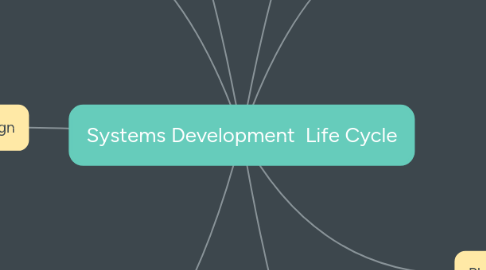
1. Phase VllI- Systems Maintenance
1.1. A formal process by which program changes can be managed to accommodate changes in user needs
1.2. Extensive Maintenances
1.3. Same treatment as new development
2. Phase VII- System Implementation
2.1. 1. Testing the system
2.2. 2. Documenting the system
2.2.1. Operator Documentation
2.2.2. User Documentation
2.2.3. User Handbook
2.2.4. Tutorials
2.2.5. Helpful Features
2.3. 3. Converting the Database
2.3.1. 1. Validation
2.3.2. 2. Reconciliation
2.3.3. 3. Backup
2.4. 4. Converting the New System (cutover)
2.4.1. Cold Turkey Cutover
2.4.2. Phased Cutover
2.4.3. Parallel Operation Cutover
2.5. 5. Post-implementation Review
2.5.1. System Design Adequacy
2.5.2. Accuracy of Time, Cost, and Benefit Estimates
3. Phase I - Systems Planning
3.1. Objective: Link individual system projects or applications to the strategic objectives of the firm.
3.2. Strategic Systems Planning: Allocates systems resources at the macro level & deals with a time frame of 3-5 years.
3.3. Project Planning: Allocate resources to individual applications within the framework of the strategic plan.
4. Phase II- Systems Analysis
4.1. System analysis report- formal report that marks the conclusion of the systems analysis phase.
4.2. 1. The survey step - System survey
4.3. 2. Gathering Facts
4.3.1. Observation
4.3.2. Task Participation
4.3.3. Personal Interviews
4.3.4. Reviewing Key Documents
4.4. 3. Analysis Steps
5. Phase III- Conceptual Systems Design
5.1. Purpose: To produce several alternative conceptual systems that satisfy the system requirements identified during systems analysis.
5.2. Types of Approaches
5.2.1. 1. Structured Design Approach
5.2.1.1. Data flow diagram (DFDs)
5.2.1.2. Structure Diagram
5.2.2. 2. Object-Oriented Approach
6. Phase IV- System Evaluation and Selection
6.1. Detailed Feasibility Study
6.1.1. 1. Technical Feasibility
6.1.2. 2. Economic Feasibility
6.1.3. 3. Legal Feasibility
6.1.4. 4. Operational Feasibility
6.1.5. 5. Schedule Feasibility
6.2. Cost-benefit Analysis
6.2.1. 1. Identify costs
6.2.1.1. One-time Costs
6.2.1.2. Recurring Costs
6.2.2. 2. Identify Benefits
6.2.2.1. Tangible Benefits
6.2.2.2. Intangible Benefits
6.2.3. 3. Compare Costs and Benefits
6.2.3.1. Net Present Value
6.2.3.2. Payback method
6.3. Systems Selection Report
7. Phase VI- Application Programming and Testing
7.1. Program the Application Software
7.1.1. Java
7.1.2. C++
7.1.3. .NET.
7.2. Testing the Application Software
7.2.1. Testing Methodology
7.2.2. Testing Offline Before Deploying Online
7.2.3. Test Data
8. Phase V- Detailed Design
8.1. Purpose: To produce a detailed description of the proposed system that both satisfies the system requirements identified during the system analysis and is in accordance with the conceptual design.
8.2. During the phase
8.2.1. Perform a system design walkthrough
8.2.1.1. To ensure the design is free from conceptual errors that could become programmed into the final system
8.2.2. Review system documentation
8.2.2.1. specify input screen formats, output report layouts, database structures, and process logic
